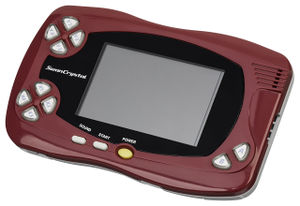Difference between revisions of "Configuration:WonderSwan"
(Created page with "== Platform Information == === Media Devices === * ROM Images == Available Emulators == Below is a list of available emulators for this platform. * [[Emulator:Mednafen|Med...") |
m (Sairuk moved page WonderSwan to Configuration:WonderSwan: namespaces changes) |
||
| (3 intermediate revisions by the same user not shown) | |||
| Line 1: | Line 1: | ||
| + | {{Infobox System|Logo=WonderSwan_logo_text.png|Image=SwanCrystal-Wine-Left.jpg|Year=1999|Manufacturer=Bandai|Type=Handheld game console|CPU=TBA|GPU=TBA|Sound CPU=TBA|Sound Chip=TBA|Memory=TBA|Controllers=Builtin}} | ||
== Platform Information == | == Platform Information == | ||
| + | ''from wikipedia'' | ||
| + | The WonderSwan (ワンダースワン WandāSuwan?) is a handheld game console released in Japan by Bandai. It was developed by Gunpei Yokoi's company Koto Laboratory and Bandai. Released in 1999 in the fifth generation of video game consoles, the WonderSwan and its two later models, the WonderSwan Color and SwanCrystal were officially supported until being discontinued by Bandai in 2003. During its lifespan, no variation of the WonderSwan was released outside Japan. | ||
| + | |||
| + | Powered by a 16-bit central processing unit, the WonderSwan took advantage of a low price point and long battery life in comparison to its competition, Nintendo's Game Boy Color and SNK's Neo Geo Pocket Color. Later improvements took advantage of quality upgrades to the handheld's screen and added color. The WonderSwan is playable both vertically and horizontally, and features a unique library of games, including numerous first-party titles based on licensed anime properties, as well as significant third-party support from Square, Namco, and Taito. Overall, the WonderSwan in all its variations combined to sell an estimated 3.5 million units and managed to obtain as much as 8% of the Japanese handheld video game console market before being marginalized by Nintendo's Game Boy Advance. Retrospective feedback praises the potential of the WonderSwan despite its low sales and its brief time holding its own against Nintendo in the marketplace. | ||
=== Media Devices === | === Media Devices === | ||
* ROM Images | * ROM Images | ||
| Line 9: | Line 14: | ||
* [[Emulator:Mednafen|Mednafen (WonderSwan)]] | * [[Emulator:Mednafen|Mednafen (WonderSwan)]] | ||
| + | |||
| + | === External Links === | ||
| + | * [https://en.wikipedia.org/wiki/WonderSwan Wikipedia] | ||
| + | * [https://en.wikipedia.org/wiki/List_of_WonderSwan_games List of WonderSwan games] | ||
| + | * [https://www.youtube.com/watch?v=VhZ3ESHJobk 20 Games That Defined the Bandai Wonderswan Color] | ||
| + | * [http://www.racketboy.com/retro/bandai-wonderswan-101-a-beginners-guide RacketBoy's Beginners Guide] | ||
| + | |||
[[Category:Platform]] | [[Category:Platform]] | ||
Latest revision as of 22:12, 4 February 2020
| WonderSwan | ||
|---|---|---|

| ||
| Manufacturer | Bandai | |
| Type | Handheld game console | |
| CPU | TBA | |
| GPU | TBA | |
| Sound CPU | TBA | |
| Sound Chip | TBA | |
| Memory | TBA | |
| Controllers | Builtin | |
| Year | 1999 | |
Platform Information
from wikipedia
The WonderSwan (ワンダースワン WandāSuwan?) is a handheld game console released in Japan by Bandai. It was developed by Gunpei Yokoi's company Koto Laboratory and Bandai. Released in 1999 in the fifth generation of video game consoles, the WonderSwan and its two later models, the WonderSwan Color and SwanCrystal were officially supported until being discontinued by Bandai in 2003. During its lifespan, no variation of the WonderSwan was released outside Japan.
Powered by a 16-bit central processing unit, the WonderSwan took advantage of a low price point and long battery life in comparison to its competition, Nintendo's Game Boy Color and SNK's Neo Geo Pocket Color. Later improvements took advantage of quality upgrades to the handheld's screen and added color. The WonderSwan is playable both vertically and horizontally, and features a unique library of games, including numerous first-party titles based on licensed anime properties, as well as significant third-party support from Square, Namco, and Taito. Overall, the WonderSwan in all its variations combined to sell an estimated 3.5 million units and managed to obtain as much as 8% of the Japanese handheld video game console market before being marginalized by Nintendo's Game Boy Advance. Retrospective feedback praises the potential of the WonderSwan despite its low sales and its brief time holding its own against Nintendo in the marketplace.
Media Devices
- ROM Images
Available Emulators
Below is a list of available emulators for this platform.